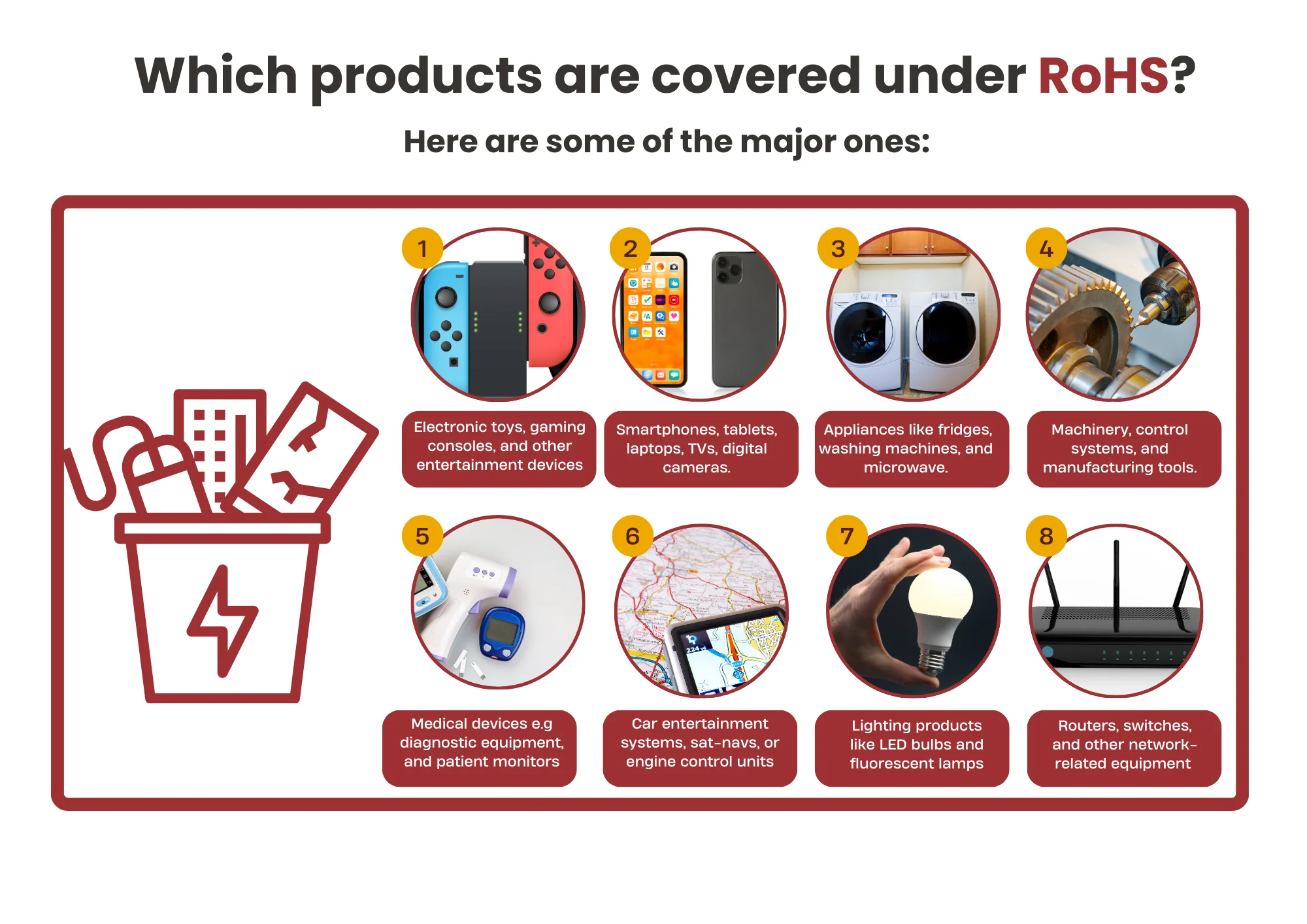
RoHS Ten Tests
RoHS is a mandatory standard established by EU legislation. Its fULl name is the "Restriction of Hazardous Substances Directive" (RoHS). This standard is mainly used to regulate the materials and process standards of electronic and electrical products, making them more beneficial to human health and environmental protection.

RoHS Ten Substances
ROHS Testing covers the following ten hazardous substances:
- Lead (Pb)
- Cadmium (Cd)
- Mercury (Hg)
- Hexavalent Chromium (Cr VI)
- Polybrominated Biphenyls (PBBs)
- Polybrominated Diphenyl Ethers (PBDEs)
- Diisobutyl Phthalate (DIBP)
- Dibutyl Phthalate (DBP)
- Benzyl Butyl Phthalate (BBP)
- Di(2-ethylhexyl) Phthalate (DEHP)
RoHS Ten Tests Target Objects
Electronic and electrical equipment, components, and various raw materials.
Importance of RoHS Ten Tests
The restriction standards for the ten hazardous substances in the RoHS Directive are essential regulations formulated to protect the environment and human health. For manufacturers and suppliers of electronic and electrical products, compliance with the RoHS Directive is mandatory. It not only enhances product market competitiveness but also meets consumers' demand for environmentally friendly products.
RoHS Ten Hazardous Substances Content Limits
1. Lead (Pb): A toxic metal mainly found in solder, glass, and PVC stabilizers. The RoHS limit is no more than 1000ppm (0.1%).
2. Cadmium (Cd): A toxic metal used in switches, springs, connectors, casings, PCBs, and batteries. The RoHS limit is no more than 100ppm (0.01%).
3. Mercury (Hg): A toxic metal found in thermostats, sensors, switches, and lamps. The RoHS limit is no more than 1000ppm (0.1%).
4. Hexavalent Chromium (Cr VI): A toxic cheMICal mainly found in metal anti-corrosion coatings. The RoHS limit is no more than 1000ppm (0.1%).
5. Polybrominated Biphenyls (PBBs): A brominated flame retardant harmful to humans and the environment. The RoHS limit is no more than 1000ppm (0.1%).
6. Polybrominated Diphenyl Ethers (PBDEs): A brominated flame retardant similar in hazard to PBBs. The RoHS limit is no more than 1000ppm (0.1%).
7. Diisobutyl Phthalate (DIBP): Used as a plasticizer in PVC plastics. The RoHS limit is no more than 1000ppm (0.1%).
8. Dibutyl Phthalate (DBP): Used in PVC components like cables, sockets, pipes, shock absorbers, and non-polymeric applications like paints, adhesives, sealants, and printing inks. The RoHS limit is no more than 1000ppm (0.1%).
9. Benzyl Butyl Phthalate (BBP): Mainly used as a plasticizer for PVC. The RoHS limit is no more than 1000ppm (0.1%).
10. Di(2-ethylhexyl) Phthalate (DEHP): Mainly used as a plasticizer for PVC. The RoHS limit is no more than 1000ppm (0.1%).
RequiRED Testing Instruments for RoHS Ten Hazardous Substances
1. Substances: Lead (Pb), Cadmium (Cd), Mercury (Hg)
- Testing Instrument: Inductively Coupled Plasma Optical Emission Spectrometer (ICP-OES)
2. Substance: Hexavalent Chromium (Cr VI)
- Testing Instrument: Ultraviolet-Visible Spectrophotometer (UV-Vis)
3. Substances: Polybrominated Biphenyls (PBBs), Polybrominated Diphenyl Ethers (PBDEs), Diisobutyl Phthalate (DIBP), Dibutyl Phthalate (DBP), Benzyl Butyl Phthalate (BBP), Di(2-ethylhexyl) Phthalate (DEHP)
- Testing Instrument: Gas Chromatography-Mass Spectrometry (GC-MS)
China JJR Laboratory provides testing services. Welcome to inquire!
Email:hello@jjrlab.com
Write your message here and send it to us
 What Are the Testing Items of California Propositi
What Are the Testing Items of California Propositi
 E-Cigarette EU TPD Testing
E-Cigarette EU TPD Testing
 Testing Certification for E-cigarettes Exported to
Testing Certification for E-cigarettes Exported to
 What is Amazon US CPC Certification?
What is Amazon US CPC Certification?
 UK Toy Safety Regulation Standard EN 71-13
UK Toy Safety Regulation Standard EN 71-13
 What is EU UFI Registration?
What is EU UFI Registration?
 EU UFI Registration for E-cigarette E-liquid
EU UFI Registration for E-cigarette E-liquid
 How to get the MSDS Report for Electronic Cigarett
How to get the MSDS Report for Electronic Cigarett
Leave us a message
24-hour online customer service at any time to respond, so that you worry!




